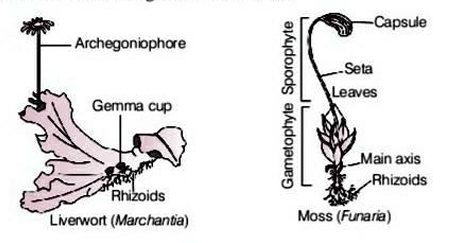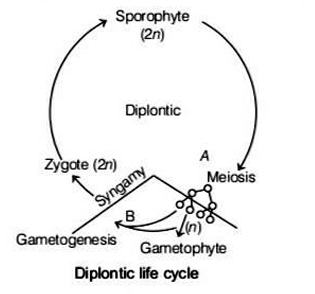Phylogenetic System Of Classification
- Plant kingdom includes all multicellular, eukaryotic, photosynthesising organisms, grouped as algae, bryophytes, pteridophytes, gymnosperms and angiosperms.
- Plants were classified on the basis of different characters.
- The various systems used in classification of plants are
- Artificial system of classification It was given by Linnaeus and based on morphological characters.
- Natural system of classification It was developed by Bentham and Hooker and based on natural affinities among the organisms. It was based on both external and internal features like anatomy, structure and embryology. It is the most common system of classification followed.
- Phylogenetic system of classification It was given by Engler and Prantl and based on evolutionary relationships of an organism. It is also known as Hutchinson's system.
- Classification done on the basis of chemical constituents of plant is known as chemotaxonomy.
- Numerical taxonomy includes classification on the basis of observed characters.
- Cytotaxonomy is based on cytological information like chromosome number, structure, behaviour and types of chromosomes.


Algae
Algae
- These are chlorophyll bearing, simple, thalloid, autotrophic and mostly aquatic organisms (both freshwater and marine water).
- These include unicellular forms like Chlamydomonas, colonial forms like Volvox, filamentous like Ulothrix and Spirogyra.
- Algae reproduce vegetatively by fragmentation and asexually by zoospores, aplanospores, akinetes, etc.
- Sexual reproduction in algae occurs through fusion of two gametes. These gametes could be
- Isogamous Both gametes are similar in size and non-motile, e.g. Spirogyra.
- Anisogamous Both gametes dissimilar in size, e.g. Chlamydomonas.
- Oogamous Fusion between one large female gamete and a smaller motile male gamete, e.g. Volvox and Fucus.
- Algae play an important role in carbon dioxide fixation on earth through photosynthesis thereby increasing the level of $\mathrm{O}_2$ in the environment. They are chief primary producers.
- About 70 species of marine algae like Porphyra, Laminaria and Sargassum are used as food.
- Algae are used commercially for various products like
- Algin from brown algae.
- Carrageenan from red algae.
- Agar from Gelidium and Gracilaria.
- Spirulina and Chlorella are used by space travellers.
The algae are divided into three main classes which are as follows


Class-Chlorophyceae (Green Algae)
Class-Chlorophyceae (Green Algae)
- Members of Chlorophyceae are unicellular, colonial or filamentous.
- They are green due to the presence of chlorophyll- a and b pigments localised in definite chloroplast.
- Shape of the chloroplast varies like discoid, plate-like, reticulate, cup-shaped, spiral or ribbon-shaped.
- Algae store food in the form of starch in a specialised structures called pyrenoids located in chloroplast. Food may be stored in the form of oil droplets in some algae.
- Inner layer of cell wall is made up of cellulose, while outer layer is made up of pectose.
- Vegetative reproduction occurs through fragmentation. Asexual reproduction is done by zoospores by zoosporangia.
- Sexual reproduction occurs through different modes like isogamous, anisogamous or oogamous, e.g. Volvox, Ulothrix, Spirogyra, Chlamydomonas and Chara.


Bryophytes
Bryophytes
- They are commonly found in moist shaded areas in the hills.
- These are known as amphibians of plant kingdom as they can live in soil as well as water and are dependent on water for sexual reproduction (for movement of gametes).
- In bryophytes, the main plant body is gametophyte, which produces gametes. It is thalloid (i.e. lacks roots, stems and leaves) and prostrate or erect and attached to the substratum by rhizoids.
- Sex organs are multicellular and jacketed. The male sex organ is antheridium, while female sex organ is archegonium.
- Antheridium produces biflagellate antherozoids. Female sex organ produces one egg.
- Antherozoids are released in water where they come in contact of archegonium and egg cell. It fuses with egg cell to produce the zygote.
- Zygote undergoes mitotic division and gives rise to sporophyte (2n). Sporophyte remains attached to the gametophyte and takes nourishment from it.
- Sporophyte undergoes reductional division or meiosis to produce haploid spores. These later germinate and give rise to haploid gametophyte.
- Bryophytes are used as food source. These are capable of preventing soil erosion and also form ecological succession links.
- Bryophytes are divided into liverworts and mosses.


Class-Rhodophyceae (Red Algae)
Class-Rhodophyceae (Red Algae)
- Members of Rhodophyceae are red due to the presence of pigment $r$-phycoerythrin. These are usually marine, occur close to the surface of water as well as in deep oceans.
- They reproduce vegetatively through fragmentation.
- They reproduce sexually and asexually through non-motile spores/gametes. Sexual reproduction is oogamous.



Liverworts
Liverworts
- The plant body is thalloid, e.g. Marchantia.
- Leafy members have tiny appendages usually grown in moist, damp, shady habitats.
- They reproduce asexually by the formation of specialised structure called gemmae or through fragmentation of thalli.
- Gemmae are asexual buds, which originate from small receptacles called gemma cups.
- Sexual reproduction occurs by the fusion of antherozoids and egg, which are produced in antheridium and archegonium, respectively.
- Both male and female sex organs may be present on same thalli or different thalli.
- Zygote gives rise to sporophyte, which is differentiated into foot, seta and capsule. Some cells of capsule undergo meiosis and give rise to haploid spores. These spores give rise to gametophyte ( n).


Mosses
Mosses
- The predominant stage in the life cycle of a moss is the gametophyte, which consists of two substages, i.e. protonema and leafy stage.
- Juvenile stage of moss is protonema. It consist of slender, green, branching system of filaments.
- Leafy stage develops from the secondary protonema as lateral bud. It bears the sex organs.
- Vegetative reproduction takes place by fragmentation and budding in the secondary protonema.
- Mosses provide food for herbivores, used as packing material, fuel (e.g. Sphagnum), they decompose rocks and colonies them along with lichens, etc.



Pteridophytes
Pteridophytes
- Pteridophytes are called vascular cryptogams, also known as seedless vascular plants.
- They produce spores rather than seeds, e.g. horsetails (Equisetum), ferns (Selaginella) and club moss (Lycopodium).
- These are found near the marshy, cool and damp places.
- In pteridophytes, the main plant body is a sporophyte $(2 n)$, which is differentiated into true root, stem and leaves.
- Leaves may be small (microphylls) as in Selaginella or large (macrophylls) as in ferns.
- Sporophyte bears sporangia which consist of leaf-like appendages called sporophylls. These sporophylls may be widely scattered in a plant or may be clustered in definite areas and structures called strobili or cones, e.g. Selaginella.
- The spores produced can be of similar kind (homosporous) or can be of two kinds (heterosporous), i.e. macro (large) and micro (small).
- The spores germinate to give rise to inconspicuous, small but multicellular free-living, mostly photosynthetic thalloid gametophyte called prothallus.
- Gametophyte can grow only in cool, damp and shady places which has restricted the spread of pteriodphytes to a narrow geographical range.
- The gametophytes bear male and female sex organs called antheridia and archegonia, respectively.


Gymnosperms
Gymnosperms
- In gymnosperms, the ovules are not enclosed by any ovary wall and remain exposed both before and after fertilisation. Thus, naked seeds are formed post-fertilisation and no fruit formation occurs.
- Plants possess tap root system but in some forms, coralloid roots (plant roots associated with endosymbionts such as blue-green alga, e.g. Cycas) or mycorrhiza (e.g. Pinus). The stems are aerial, erect, woody, branched or unbranched.
- Leaves are usually dimorphic, i.e. leaves are of two types viz, large green foliage leaves and small brown scale leaves.
- The gymnosperms are heterosporous, i.e. produce microspores and megaspores in a compact strobili or cones.
- The strobili bearing microsporophylls and microsporangia are called microsporangiate or male strobili. These develop into a highly reduced male gametophyte which produce pollen grains.
- The cones bearing megasporophylls with ovules or megasporangia are called macrosporangiate or female strobili.
- Ovules or megasporangia borne on megasporophylls consist of nucellus from which a megaspore mother cell develops.
- One megaspore out of four develops into female gametophyte bearing two or more archegonia (female sex organs).
- The pollen grains of gymnosperms germinate and release male gamete into the ovule, where it forms zygote after fertilisation. The zygote develops into embryo and ovules into seeds (naked).


Angiosperms
Angiosperms
- Unlike the gymnosperms where the ovules are naked, in the angiosperms or flowering plants, the pollen grains and ovules are developed in specialised structures called flowers.
- The flower consists of the male sex organs, called the stamen and female sex organ, called the pistil or carpel.
- Each stamen consists of a filament and an anther (produces pollen grain). The pistil consists of an ovary enclosing one to many ovules, a long slender style and a stigma (structure where pollen grain lands after pollination).
- Each ovule has a megaspore mother cell which forms four haploid megaspores by meiosis. Out of which, one divides to form an embryo sac and others degenerate.
- The pollens reach the stigma of a flower through agencies such as wind, water, insects, etc. This is known as pollination.
- Each embryo sac has 3-celled egg apparatus having 1-egg cell, 2-synergids, 3-antipodal cells and 2-polar nuclei.
- The pollen tube carrying the microspore (pollen grains) enters the embryo sac. One male gamete fuses with egg cell (syngamy) and other fuses with diploid secondary nucleus (triple fusion) forming primary endosperm nucleus. Due to the occurrence of two processes simultaneously, this is called double fertilisation.
- The zygote develops into embryo and primary endosperm nucleus provides nourishment to the growing embryo.
- The synergids and antipodals develop after fertilisation. Also, the ovaries develop into fruit and ovules develop into seeds.
- The angiosperms are classified into two classes-Dicotyledons and Monocotyledons.


Plant Life Cycle And Alternation Of Generations
Plant Life Cycle and Alternation of Generations
- Sexually reproducing plants show alternation of generations between haploid gametophyte and diploid sporophyte. However, different plant groups as well as individuals may show different patterns of life cycles, haplontic, diplontic and intermediate (haplo-diplontic). These can be explained as
1. Haplontic life cycle is followed by algae such as Spirogyma, Volvox, etc. In this cycle, gametophyte is dominant and sporophyte is represented by single-celled zygote. Zygote undergoes meiosis to form haploid spores. These spores give rise to haploid gametophyte after a mitotic cell division. Most algal generas are haplontic with a few


 beeTokens
beeTokens 



